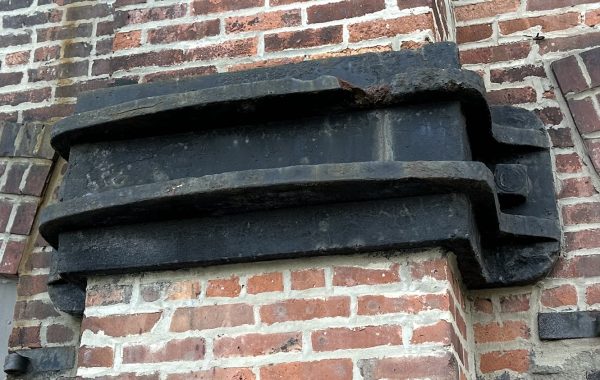Part 1, General: here.
Part 2, Structure: here.
So on Tuesday I effectively said that Adelaide House was either small for a skyscraper or forty years behind the times, and yesterday I said that the steel was pretty familiar for an old skyscraper but maybe a little old-fashioned. Today is different. The facades of this 1925 building in London – non-structural curtain walls – are in my opinion closer in spirit to their bearing-wall neighbors than they are to their contemporaries in the US. Starting with a view up from the base:

You can certainly find mid-1920s curtain-wall facades in the US where the veneer is all ashlar stone, but they’re not so common, and the same can be said about bearing-wall veneer. The US simply did not have the depth of stone masonry industry that you found in Europe then, arguably because we prioritized speed of construction and first cost. Carving stone for a large facade takes time and money and was therefore far more common on government buildings than on commercial ones, where stone was usually used for the base and some trim. I found out some years ago that you can generally surprise European architects and engineers by pointing our how much of the facades of our older skyscrapers is terra cotta and cast stone. So the all-stone veneer here for a commercial building feels odd. The stone cornice goes well beyond feeling odd: I can’t offhand think of a single tall building in New York with a cornice that isn’t sheet metal or terra cotta. The rear facades are mostly brick:

And there’s a good look at the end of that incredible cornice:

The walls are thicker than their New York counterparts, which in the mid-1920s were generally three wythes (12 inches) of brick with the inside wythe maybe being terra cotta and the outside being whatever decorative veneer was used.

The damage looks familiar although not as bad as I’m used to. More on that below. First, some cracks at a discontinuity in stiffness – look at the sill of the narrow window next to the “Danger / Keep Out” sign. The masonry right below that window is subjected to pretty much no load, while the piers on either side are (at least) subjected to a full floor of load and (more likely) subjected to the load of the full height of the building because the lack of expansion joints means the masonry has inadvertently stacked up.

For some nice steel damage, here’s an upper-floor spandrel beam, protected by cast-in-place concrete fireproofing and with some smallish holes through the web:

But the real fun, and the most familiar sight, is on the corner:

There are two main causes of this kind of corner cracks – thermal movement of a wall without expansion joints, and rust-jacking at the corner columns – and they often feed off one another. Thermal movement creates a crack, which allows water in, which causes rust-jacking, which breaks the corner masonry further, which allows more extreme thermal movement…it’s a whole thing. The cracks here are something I’ve seen in dozens of projects and, walking around, in hundreds of other buildings.
The steel at Adelaide is better protected by the original construction than the steel in peer buildings in New York (the endless rows of 12- to 14-story apartment houses along West End Avenue, for example, are fairly close in size and age) but also by circumstance. New York has annual rainfall of over 46 inches per year versus about 23 inches for London. (We have many more sunny days in New York, with that twice-as-much rain packed into heavier downpours.) New York traditionally (this is changing) has average low temperatures below freezing in December, January, and February, while London has no month with average lows below freezing. In short, we have weather that is much more destructive to masonry via freeze-thaw action. It gets worse: the spread from the hottest summer highs to the coldest winter lows is 58 degrees F in New York (84F in July and August versus 26F in January) 34 degrees F in London (74F in July and August versus 40F in December, January, and February). Thermal movement is proportional to the change in temperature, so we can expect some 70 percent more movement in New York. And our thinner facades mean that the temperature change is more evenly distributed through the thickness of the masonry, while London’s thicker walls better self-insulate the inner portions of the maosnry.
TL;DR: there are reasons our old steel-frame buildings are in worse shape than the Adelaide House, and some of them are just bad luck.




You must be logged in to post a comment.